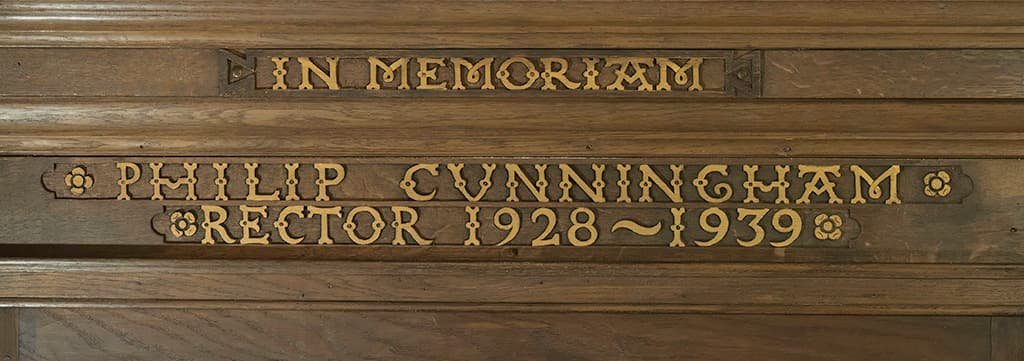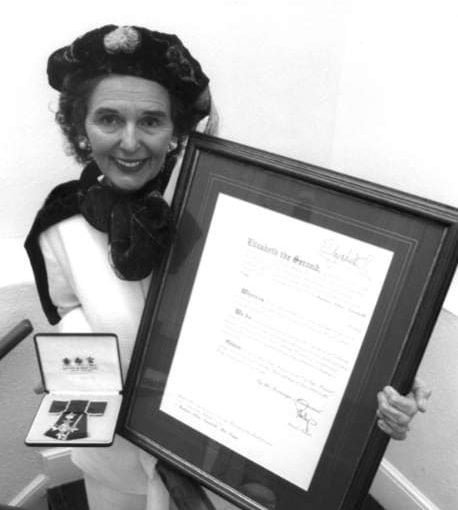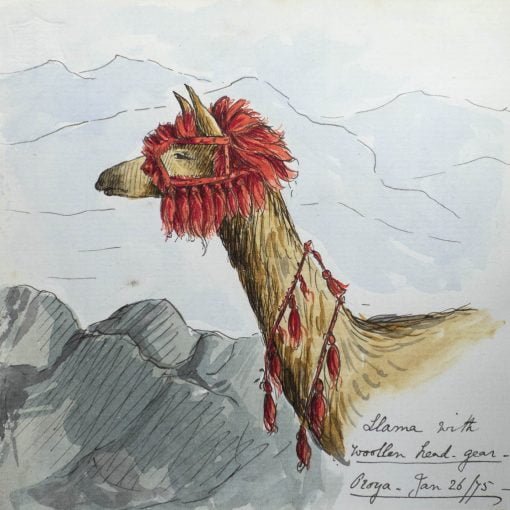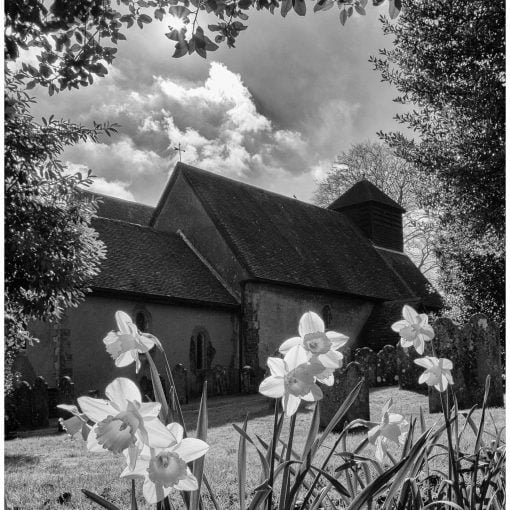The first in a planned series of three articles the memorial and the two rectors commemorated.
Reprinted, with minor updates, from the March 2022 issue of Compton & Shawford Parish Magazine
Introduction
Most visitors to Compton Church probably walk straight towards the light and airy south aisle. If they notice anything in the north aisle, the old Norman part of the church, it’s probably the stained glass window. It was given by Mrs. Simeon in memory of her grandfather Philip Williams, rector 1781-1830.
But if you look closely at the dark wooden panelling below the window, you’ll see that it commemorates two former rectors, Cecil Cooper and Philip Cunningham.


Compton “old church”

Why them? And why then?
Both men made a huge contribution to the life of the parish, as we shall see in parts 2 and 3 of this short series.
Cecil Cooper had gone on to be Dean of Carlisle, but on retirement in 1938 he returned to live here.
Eighty years ago, in early 1942, they died within a few weeks of each other.
Cecil Cooper died on 6 January, aged 70.
Philip Cunningham, who had retired to live in Winchester, died on 9 February, aged 75.
Why Oak Panelling?
Local architect Herbert Kitchin had designed the choir stalls and the oak panelling behind the altar shortly after Compton Church was extended in 1905. Later he designed the panelling around the font which commemorates Charles Blackett, rector 1917-1928.
Kitchin had also designed the War Memorial Panelling in Twyford church shortly after the Great War.
When you’re in Winchester, you can pop into St. Lawrence Church (entrance in the little underpass near the Butter Cross) and see more Kitchin-designed Great War memorial panelling there.
So when he proposed a joint memorial to these two rectors in 1942, it was approved and the funds were raised.
A Quiet Wedding
This sad notice appeared in the Portsmouth Evening News, Saturday 31 January 1903
A Quiet Wedding
It transpires that the second daughter of the Dean of Winchester, Dr. Stephens, was quietly married in Winchester Cathedral on Tuesday to the Rev. C.H.H. Cooper, son of the Vicar of Emery Down, Lyndhurst.
The Dean’s daughter, also called Cecil, would have been looking forward to being given away by her father in Winchester Cathedral when she married the up-and-coming young curate Cecil Cooper.
But the Dean’s unexpected death just before Christmas 1902 had ruined their wedding plans.
A Fatal Banquet
It was the custom at that time for Winchester Town Council to hold a meeting in early November for the election of the new Mayor. In the evening there would be a grand banquet in honour of the outgoing mayor.
After the 1902 Mayoral banquet, held on 10 November, many of the guests became ill and four of them died. One of these was the Dean of Winchester, Dr. William Richard Wood Stephens, who died on 22 December.
The Dean’s funeral in Winchester Cathedral on 27 December was attended by many dignitaries. The Bishop of Winchester, Randall Davidson, was away in Canterbury for the funeral on the same day of Archbishop Frederick Temple who had been ill for several months and had died on 23 December.
On 9 January it was announced that Randall Davidson would be the next Archbishop of Canterbury.
Local Connections
Present at the fatal banquet were Mr. Henry White, the County Coroner, of Shawford Close, and John Barnes Colson, Cathedral Architect, who had built Red Lane House. Ex-Mayor Cancellor’s predecessor as Mayor was Alfred Bowker, who built The Malms.
Rev. and Mrs J.H. Cancellor, the parents of the outgoing mayor, Bertram Cancellor, had lived at Combe Down, Shawford.
Medical Officer’s Report
Dr. Langdon, the Winchester Medical Officer for Health, looked at alleged causes of the illness
- Soup cooked in copper vessels
- Oysters from beds polluted with sewage
- The condition of the Guildhall drains
- Infection in the house of the person providing the dinner
He concluded that the oysters were the probable cause.
Mayoral Banquet Menu
10 November 1902
oysters
clear soup
thick soup
smelts
turbot
sweetbread
kidneys & mushrooms
boiled mutton
roast mutton
roast beef
venison
currant jelly
capons
ham
tongue
turkey
pheasant
partridge
Sir Watkin Wynn pudding
Charlotte russe
liqueur jellies
caramel cream
maraschino cream
meringue
ice
cheese
salad (celery)
aerated water
Local Government Board Report
Because there had been cases of enteric fever (now called typhoid) at Emsworth, Portsmouth and at Mayoral banquets in Winchester and Southampton, the Local Government Board instructed Dr. H. Timbrell Bulstrode to investigate and report[1]Dr. H. Timbrell Bulstrode’s Report to the Local Government Board upon alleged Oyster-borne Enteric Fever and other Illness following the Mayoral Banquets at Winchester and Southampton, and upon … Continue reading.
He circulated a detailed questionnaire to all the attendees.
Out of the total 134 guests at the Winchester banquet, no less than 62, or 46.3 per cent, were attacked with illness of some kind or other, mostly gastro-enteritis. Ten people (nine guests and one waiter) had developed typhoid. Four of the typhoid victims died. Of the 62 who became ill, all but two had had oysters.
Of the ten with typhoid, all had eaten oysters and there was no other dish in common.
The oysters for the Winchester and Southampton banquets had come from the same supplier in Emsworth, where the oyster ponds were close to the sewage outfall.
The bottom dropped out of the oyster market.
The owner of the oyster company, a Mr. Foster, sued the Warblington Urban District Council for damages and sought an injunction against discharge of sewage near the oyster beds.
He won the case and, after the decision was upheld on appeal, was awarded £850 damages. The injunction was not granted.
The Muckabite controversy
In the mid-19th century, Winchester had no mains drainage. The brooks through the city still carried sewage. The supply of running water from the new Winchester Water Works Co. just made things worse as the output of water closets could only go downhill, making the lowest end of town even more unsavoury.
There was a standoff between the “Muckabites” on the City Council, mostly small businessmen and shopkeepers, who wanted to keep city taxes low by not investing in mains drainage, and the “anti-Muckabites”, medical people and others including Dean Garnier, who could see the effect that untreated waste was having on health and life expectancy.[2]Health and Sanitation in Victorian Winchester or: The Triumph of the MuckabitesBy W H Boorman, Proc. Hampsh. Field Club Archaeol. Soc. 46, 1990, … Continue reading
Winchester only installed mains drainage when forced to do so by central government[3]The Sanitary Act, 1866
https://en.wikipedia.org/wiki/Sanitary_Act_1866. It was 1876 when the City Council gave the go ahead to the Sewerage Scheme. The foundation stone of the Garnier Road pumping station engine house was laid on 2nd May 1878[4]Garnier Road Sewage Pumping Station, Winchester by Martin Gregory, Hampshire Industrial Archaeology Society
https://www.hias.org.uk/Journal%20scans/HIAS%20Journal%202005b.pdf
And today?
Fast forward to 2022 and we see continuing controversy over the amount and frequency of sewage being discharged into rivers and the sea, and the effectiveness of the legislation.
Recommended reading: Bloody British History – Winchester. Available in hard copy, and electronically for Kindle, Apple, Google and Kindle devices.

Next (Part 2 in this series): Rev C.H.H. Cooper, who united the parish behind the plans for the 1905 church extension.
Adrian Walmsley
for the C&S Local History Society
References
| ↑1 | Dr. H. Timbrell Bulstrode’s Report to the Local Government Board upon alleged Oyster-borne Enteric Fever and other Illness following the Mayoral Banquets at Winchester and Southampton, and upon Enteric Fever occurring simultaneously elsewhere, and also ascribed to Oysters. HMSO 1903. https://www.biodiversitylibrary.org/item/188441 |
|---|---|
| ↑2 | Health and Sanitation in Victorian Winchester or: The Triumph of the Muckabites By W H Boorman, Proc. Hampsh. Field Club Archaeol. Soc. 46, 1990, 161-180 https://www.hantsfieldclub.org.uk/publications/hampshirestudies/digital/1990s/vol46/Boorman.pdf |
| ↑3 | The Sanitary Act, 1866 https://en.wikipedia.org/wiki/Sanitary_Act_1866 |
| ↑4 | Garnier Road Sewage Pumping Station, Winchester by Martin Gregory, Hampshire Industrial Archaeology Society https://www.hias.org.uk/Journal%20scans/HIAS%20Journal%202005b.pdf |




